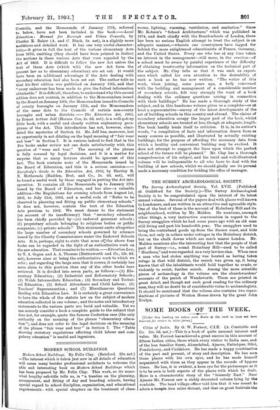C URRENT LITERAT URE.
SOME BOOKS ON THE EDUCATION ACT.
The Education Act, 1902. By Montague Barlow and H. Masan. (Butterworth and Co. 35. 6d. net.)—This book will be useful to those who wish to understand the Education Act of last year. It contains a slight sketch of the law from 1E00 to 1902, a useful summary of the Cookerton case, and a clear statement of the financial position before 1902. The summary of the new Education Act will be found to be lucid, and therefore valuable, while the suggestions for the action to be taken by local authorities during the transition period before the Act comes into operation will be found useful. The Board of Education Memorandum on Section 11, issued on December 20th„ and the National Society's recommendations in connection with this Memorandum, are printed ; and valuable draft-schemes (a) for a County Edueation Committee (similar to that adopted, by the Surrey County Council), and (b) for a group of managers of non- provided schools, are also given. We notice, however, that the impOrtant Memorandum of January 13th, summarising the powers and duties of the Board of Education and the County Councils, and the Memoranda of January 17th, referred to below, have not been included in the book.—Local Education : Manual for Borough and Urban Councils, by Charles E. Baker (A. and C. Black, 55. net), is a slightly more ambitious and detailed work. It has one very useful character- isticrit in full the text of the various elementary Acts from 1870, omitting. (they should have been printed in italics) the sections in these various Acts that were repealed by the Act of 1902. It is difficult to follow the new Act unless the text of these Acts (which with the new Act form the present law as to elementary education) are set out. It would have been an additional advantage if the Acts dealing with secondary education had also been set out. The author tells us that his first edition was published on January 15th, and that "every endeavour has been made to give the fullest information obtainable." It is difficult, therefore, to understand why this second edition does not contain, in addition to the Memorandum issued by the Board on January 13th, the Memorandum issued to Councils of county boroughs on January 17th, and the Memorandum of the same date to the Councils of certain non-county boroughs and urban districts. — The Education Act, 1902, by Ernest Arthur Jelf (Horace Cox, 2s. 6d. net), is a well-got-up little book, with a useful and clearly written explanatory para- phrase of the Act. This introduction has not, however, eluci- dated the mysteries of Section 10. Mr. Jelf has, moreover, lost an opportunity in not dilating on the legal meaning of " fair wear and tear" in Section 7. It is curious indeed to find that in the five books under review not one deals satisfactorily with this question of " wear and tear." The meaning of the phrase is fully covered by legal decisions, and it is a matter for surprise that so many lawyers should be ignorant of this fact. The book contains none of the Memoranda issued by the Board of Education, and this is a serious omission.— Everybody's Guide to the Education Act, 1902, by Hartley B. N. Mothersole (Hadden, Best, and Co., 2s. 6d. net), will be found a useful work by those engaged in putting the Act into operation. It contains all the Memoranda up to January 17th issued by the Board of Education, and has also—a valuable addition—the Regulations for evening schools from August 1st, 1902, to July 31st, 1903, and a useful code of "Rules to be observed in planning and fitting up public elementary schools." It does not, however, contain the text of the Education Acts previous to 1902. We must demur to the statement (on account of its insufficiency) that " secondary education has been chiefly provided by—(a) endowed grammar schools ; (b) proprietary schools belonging to religious bodies or public companies; (c) private schools." This statement omits altogether the large number of secondary schools governed by schemes issued by the Charity Commissioners under the Endowed Schools Acts. It is, perhaps, right to state that none of: the above four books can be regarded in the light of an authoritative work on the new education. That remains to be written.—Edu cation Law, by T. A. Organ and A. A. Thomas (Butterworth and Co., 12s. 6d. net), however aims at being the authoritative work to which we refer; and regarding the large area that it covers, it certainly has more claim to this position than any of the other books here reviewed. It is divided into seven parts, as follows :—(1) Ele- mentary Education; (2) Industrial and Reformatory Schools ; (3) Welsh Intermediate Education ; (4) Secondary and Techni- cal Education; (5) School Attendance and Child Labour ; (6) Teachers' Superannuation ; and (7) Miscellaneous Questions Dealing with Education Law. It is certainly a great convenience to have the whole of the statute law on the subject of modern education collected in one volume ; and the notes and introductory statements to the various parts are lucid and valuable. Yet we can scarcely consider a book a complete guide to the subject that does not, for example, quote the famous Cockerton case (the only authority on the meaning of the phrase "elementary educa- tion"), and does not refer to the legal decisions on the meaning of the phrase "fair wear and tear" in Section 7. The "Table showing statutory regulations affecting child labour and com- pulsory education" is useful and ingenious.











































 Previous page
Previous page